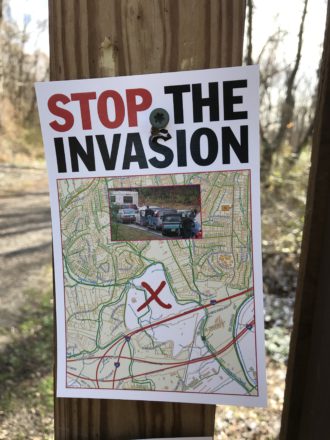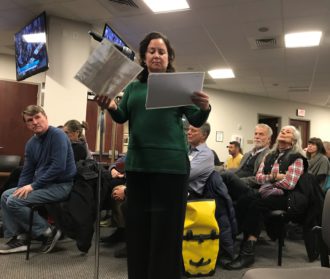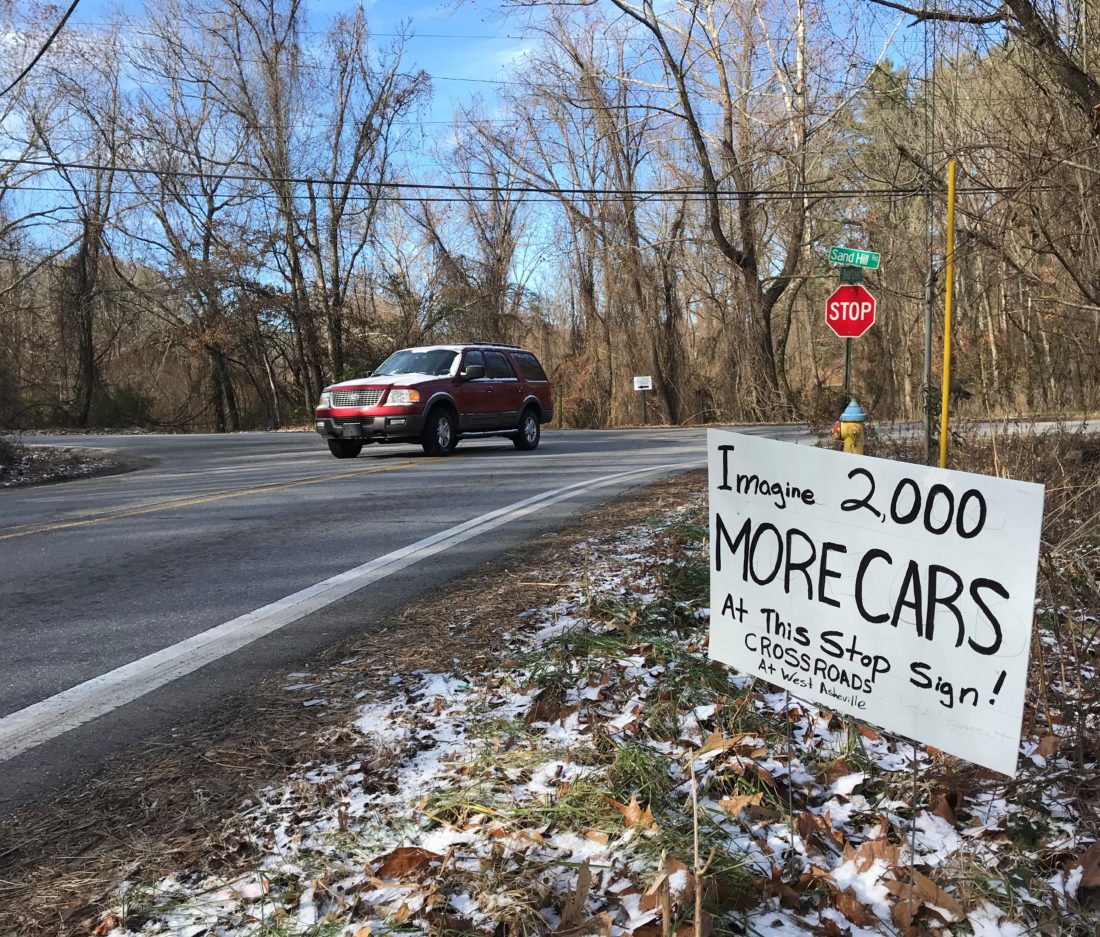West Asheville residents and the developers who want to put 802 apartments plus retail and office space on the southern edge of the community won’t know until next year whether a key county board will give the project a thumbs up.
Crossroads at West Asheville would bring buildings and roads to what is now a virtual island of fields and forest off South Bear Creek Road and significantly increase the number of rental units available in Buncombe County. It has become a flashpoint for residents worried about overdevelopment, loss of green space and traffic congestion but has gained support from some people who favor a boost to the local housing supply.
Crossroads would be among the largest development projects of its kind in Buncombe County history. The process of deciding whether to approve it may set its own record for length, with the county Board of Adjustment so far taking close to 10 hours spread across two meetings a month apart.

And it is not over yet.
Before an overflow crowd, the board heard testimony and debate for about seven hours on Dec. 11. In the face of estimates that the meeting could stretch past midnight, the board delayed the rest of the discussion to Thursday, Jan. 23.
“I think we’re just getting overwhelmed and we’re getting tired,” said board member Dot Cordell.
Community debate over Crossroads has been building for weeks. The Friends of Hominy Creek Greenway issued a statement Nov. 8 opposing the current plans and asking for changes while Buncombe Citizens Concerned About Crossroads recently set up a website voicing their worries. “STOP THE INVASION,” implores a flyer distributed by opponents.
On the other side are developers Catalyst Capital Partners of Charlotte, who say their plans treat the 68-acre site with respect, and those who argue that increasing the supply of housing will reduce upward pressure on already high apartment prices.
“We have a dire need of additional housing in Buncombe County,” attorney Lou Bissette, who represents the developers, told the Board of Adjustment on Dec. 11. “Of the people who come to work every day in Buncombe County, 40% of them commute in from other counties, and they do that because of a lack of adequate housing in Buncombe County.”
In the county, near the city
The Crossroads site is unusual in being a large piece of undeveloped land alongside a freeway that lies only about 3 1/2 miles from the center of Asheville.
Its grassy fields and stands of large hardwoods are bounded by Hominy Creek to the east and north, South Bear Creek Road and Crossroads Church to the west and Interstate 240 to the south. The church, which owns much of the property, would remain after development is completed.
Much of the land is low-lying and susceptible to flooding. Most of the 16 principal buildings on the site would be outside the 100-year flood plain, and the five to be built partially or entirely within it would be elevated 2 feet above flood level.
About a mile of greenway, with a gravel path open to the public, would run alongside Hominy Creek. A city-owned greenway lies on the opposite bank of Hominy Creek for part of that distance.
Getting approval from the Board of Adjustment is probably the biggest hurdle Crossroads must clear, although other regulatory agencies will also review specific aspects of the plan. Whatever decision the board makes could be appealed in Superior Court.
The land to the north, east and west of the site is inside Asheville city limits and holds several residential neighborhoods, but the site is in Buncombe County’s zoning jurisdiction. State law gives most North Carolina municipalities zoning authority over property up to a mile, and sometimes more, outside their limits. However, the state General Assembly took that power away from Asheville in 2013 at the urging of then-Reps. Tim Moffitt and Nathan Ramsey, both Republicans.
Tailored to the land?
Nearly 250 people turned out for the Dec. 11 Board of Adjustment meeting. They heard developers and their representatives detail efforts to eliminate adverse impacts on the land, as well as neighbors and residents voice worries about the floods of water — and of vehicles — they said Crossroads will worsen.
A.J. Klenk, a principal with developer Catalyst, noted that Crossroads Church publicly stated in the early 1990s that it would eventually sell adjoining property that it did not need. Bissette said the apartments would rent at market rates and some would be set aside as senior citizen housing.
The church, Klenk noted, has rejected proposals from other companies to level the hill on the property, fill in areas close to Hominy Creek and build high-end single-family homes or put a Sam’s Club or Walmart on the land. He added that the church chose Catalyst partly because its plans are more inclusive, have less impact on the land and meet community needs.
Engineer Chris Day with Civil Design Concepts said Catalyst was the only developer proposing a public amenity like the greenway and that the buildings, generally two or four stories, would be clustered away from Hominy Creek to reduce land disturbance. All but one structure would be at least 150 feet from neighboring residents’ property lines, he said.
Landscape architect Jason Gilliland said the greenway path fits into Buncombe County’s plans to extend a greenway westward to Enka-Candler. The process of governments developing greenways has been “painfully slow,” he said, taking up to five years or more and hundreds of thousands of dollars.
Developers proposed installing traffic signals at two closely spaced intersections on Bear Creek and South Bear Creek roads just to the northwest of the site, and the state Department of Transportation plans to increase travel lanes at Brevard Road’s interchanges with I-240 and Interstate 40 as part of the I-26 Connector project. Jeff Moore, a traffic engineer hired by the developers, said those changes will make traffic flow at those intersections better in 10 years than it would if Crossroads and the road improvements aren’t built.
DOT plans say a contract for the I-26 Connector, which will include a new crossing of the French Broad River near downtown and widening I-240 in West Asheville, will be awarded during its 2020-21 fiscal year.
But John Noor, an attorney for the Crossroads opponents, noted that the project has been studied and postponed for years. He said Moore couldn’t be certain when improvements along Brevard Road will happen or exactly what they will be.
Neighborly unwelcome

Neighbors and their attorneys told the board that Crossroads would harm their property values and quality of life.
As South Bear Creek Road resident Jolene Elkins spoke, television screens showed a pleasant photograph of part of the Crossroads site, a mowed field in the foreground with some large trees farther away. “I will lose that view, which is the primary reason I purchased that property,” she said.
Bennett Corpening said that Mount Pisgah can be seen from his mother’s home on Shelburne Road today. If Crossroads is built, “Basically, we’re going to be looking up at these large buildings to the west,” he said.
And Jacob McLean, a water resources engineer who lives in the Malvern Hills neighborhood near the site, said Crossroads will increase flooding problems and pollutants washing into Hominy Creek.
Crossroads Church and a few buildings near the Crossroads site are already considered flood prone, he said. Development in the flood plain will reduce the land’s capacity to store floodwaters during a storm, resulting in higher floods and faster flowing water on and near the site, he explained.
The developers currently propose building basins for ponds and other detention areas to hold runoff. McLean said the basins meet the state’s legal requirements but that state regulators consider them a “substandard” method for dealing with pollutants in stormwater.
Traffic experts hired by project opponents won’t get to speak until the next board meeting in January. But Kate Millar, incoming president of the Malvern Hills Neighborhood Association, said the area already sees major traffic backups at peak times.
Elkins predicted more congestion as well. “I just don’t see a two-lane road handling” traffic, she said.




The citizens are fully justified in their anger towards this massive project. This is not the type of development Asheville needs or wants. The problem goes back to the County Zoning that was quietly passed a number of years back. That zoning increased density on many parcels of land. Most people knew about it but didn’t give it much pause.
I predict this project will be approved by the Board of Adjustment, like many other bad one that have been proposed before.
The solution to this mess is for the citizens of Buncombe County and Asheville to demand changes to the zoning itself. This takes the pressure off the Board of Adjustment and sets realistic expectations for developers. This is the solution that the developers and pro-excessive development politicians don’t want the citizenry to know. They would rather citizens get worn down protesting project after project.
Yes, it’s a big project, but that’s a massive amount of land not being used for housing. The developers seem well within their rights to provide housing and other amenities on this property. I trust that the existing roads will be enhanced to provide for increased traffic. Zoning has consequences as it was intended. Make gentrification great again !